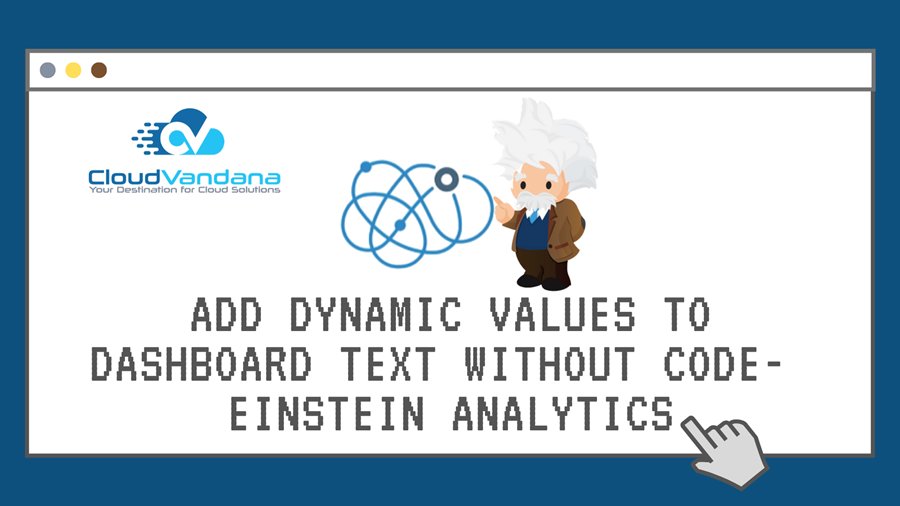Add Dynamic Values to Dashboard Text Without Code – Einstein Analytics

Learn how to add dynamic values to text in Einstein Analytics dashboards without using code. Boost clarity, personalization, and storytelling with this complete guide from CloudVandana. Modern business users don’t just want dashboards—they demand smart dashboards. Dashboards that don’t just display static metrics but evolve in real-time, respond to filters, and surface insights dynamically. In the Salesforce ecosystem, Einstein Analytics (now part of CRM Analytics) enables precisely that. One of the most underutilized yet powerful features of Einstein Analytics is the ability to add dynamic values to dashboard text—without writing any code. This guide explores how to deliver personalized, context-aware dashboard text using declarative tools in Einstein Analytics. Whether you’re building an executive summary dashboard or a sales performance tracker, mastering this technique will drastically elevate the clarity and storytelling power of your dashboards. Table of Contents 1. What Is Einstein Analytics? 2. The Role of Text Widgets in Dashboards 3. Why Dynamic Text Matters 4. Dynamic Text vs. Static Text: Key Differences 5. Traditional Methods: Code-Based Binding 6. The No-Code Approach: Binding Made Declarative 7. Prerequisites Before You Begin 8. Step-by-Step: Add Dynamic Text Without Code Step 1: Open Dashboard in Edit Mode Step 2: Drag a Text Widget Step 3: Insert Text with Dynamic Variables Step 4: Apply Filters (Optional) Step 5: Preview and Save 9. Supported Data Types and Bindings 10. Using Filters to Drive Dynamic Text 11. Real-World Use Case: Sales Summary by Quarter 12. Use Case: Executive Overview with KPI Highlights 13. Use Case: Role-Based Messaging in Embedded Dashboards 14. Tips for Cleaner Visual Communication 15. Common Pitfalls and How to Avoid Them 16. How This Enhances Data Literacy Across Teams 17. Using Dynamic Text in Lightning App Pages 18. Maintaining Performance While Using Bindings 19. Limitations to Be Aware Of 20. Future of Declarative Dashboard Building in Salesforce FAQs Final Thoughts and How CloudVandana Can Help YOU MIGHT ALSO LIKE 1. What Is Einstein Analytics? Einstein Analytics—now known as CRM Analytics—is Salesforce’s advanced analytics and business intelligence platform. It goes beyond traditional reports by offering customizable dashboards, machine learning-powered predictions, and highly visual data storytelling tools. 2. The Role of Text Widgets in Dashboards In any dashboard, text widgets are crucial for context. Whether you’re highlighting a top performer, displaying a date range, or calling out anomalies, the text element is how you communicate meaning—not just metrics. 3. Why Dynamic Text Matters Static text is fine when nothing changes. But in real-world scenarios: Dynamic text ensures the dashboard narrative adapts in real-time—adding clarity, personalization, and interactivity. 4. Dynamic Text vs. Static Text: Key Differences Feature Static Text Dynamic Text Updates with filters ❌ ✅ Custom per user ❌ ✅ Needs code ❌ ❌ (declarative possible) Drives engagement 🚫 ✅ Dynamic text tells a living story—static text is just a caption. 5. Traditional Methods: Code-Based Binding Before the no-code improvements, dynamic values required: While powerful, these methods demanded deep technical expertise and were prone to user error. 6. The No-Code Approach: Binding Made Declarative Salesforce introduced enhanced text widgets that let you bind data directly—without touching a single line of code. This innovation allows any admin or analyst to insert variables into text using: It’s as simple as writing a sentence with dynamic placeholders. 7. Prerequisites Before You Begin Make sure: 8. Step-by-Step: Add Dynamic Text Without Code Step 1: Open Dashboard in Edit Mode Navigate to CRM Analytics > Dashboards > [Your Dashboard] > Click Edit Step 2: Drag a Text Widget From the component panel, drop a Text Widget onto the canvas Step 3: Insert Text with Dynamic Variables Click inside the text box and type something like:Top performing region this month is: {{topRegion.value}} The variable topRegion must match the chart or selection’s Widget Name. Step 4: Apply Filters (Optional) If a filter is tied to the widget, the text will update when the filter value changes. Step 5: Preview and Save Click Preview to test it live, then Save your dashboard. 9. Supported Data Types and Bindings You can bind to: These values update dynamically as users interact with the dashboard. 10. Using Filters to Drive Dynamic Text Let’s say your dashboard has a Region Filter and a Top 5 Accounts Table. You can dynamically add text that says: You’re viewing performance for: {{RegionFilter.selection}} The text will automatically change based on the user’s selection—no refresh needed. 11. Real-World Use Case: Sales Summary by Quarter Scenario: A Sales Manager wants to view quarterly summaries dynamically. Text Widget Example:In {{quarterFilter.selection}}, the total pipeline was ${{totalPipeline.value}} and the close rate was {{closeRate.value}}%. This enables rapid decision-making without additional clicks. 12. Use Case: Executive Overview with KPI Highlights Scenario: The CEO opens the dashboard weekly and wants key KPIs at a glance. Text Widget Example:As of {{todayDate.value}}, our top-performing product is {{topProduct.value}}, contributing {{topProductShare.value}}% of total revenue. Text transforms from passive label to active insight. 13. Use Case: Role-Based Messaging in Embedded Dashboards Scenario: Embedded dashboard in Experience Cloud page for different partner types. Use {{User.Role}} or widget-driven text to say:Welcome, {{userName}}. Here are your opportunities for {{partnerRegion.selection}}. It creates hyper-personalized storytelling. 14. Tips for Cleaner Visual Communication Good dashboards don’t just report—they converse. 15. Common Pitfalls and How to Avoid Them Issue Solution Variable doesn’t render Check widget or filter name matches exactly Text shows blank Ensure a selection has been made Numbers appear raw Use Number Formatting in Widget settings Too many variables Keep messages focused; split across widgets if needed 16. How This Enhances Data Literacy Across Teams Dynamic text bridges the gap between technical charts and non-technical stakeholders. By summarizing key values in plain language, dashboards become narrative tools—not just data walls. This empowers: 17. Using Dynamic Text in Lightning App Pages If your dashboard is embedded in a Lightning App Page: It enhances contextual awareness inside Salesforce records. 18. Maintaining Performance While Using Bindings Dynamic text is lightweight, but poor widget naming or multiple nested selections can degrade performance. Tips: 19. Limitations to Be Aware Of Despite these, the tradeoff






